sensor TOYOTA iA 2016 (in English) User Guide
[x] Cancel search | Manufacturer: TOYOTA, Model Year: 2016, Model line: iA, Model: TOYOTA iA 2016Pages: 588, PDF Size: 5.15 MB
Page 69 of 588
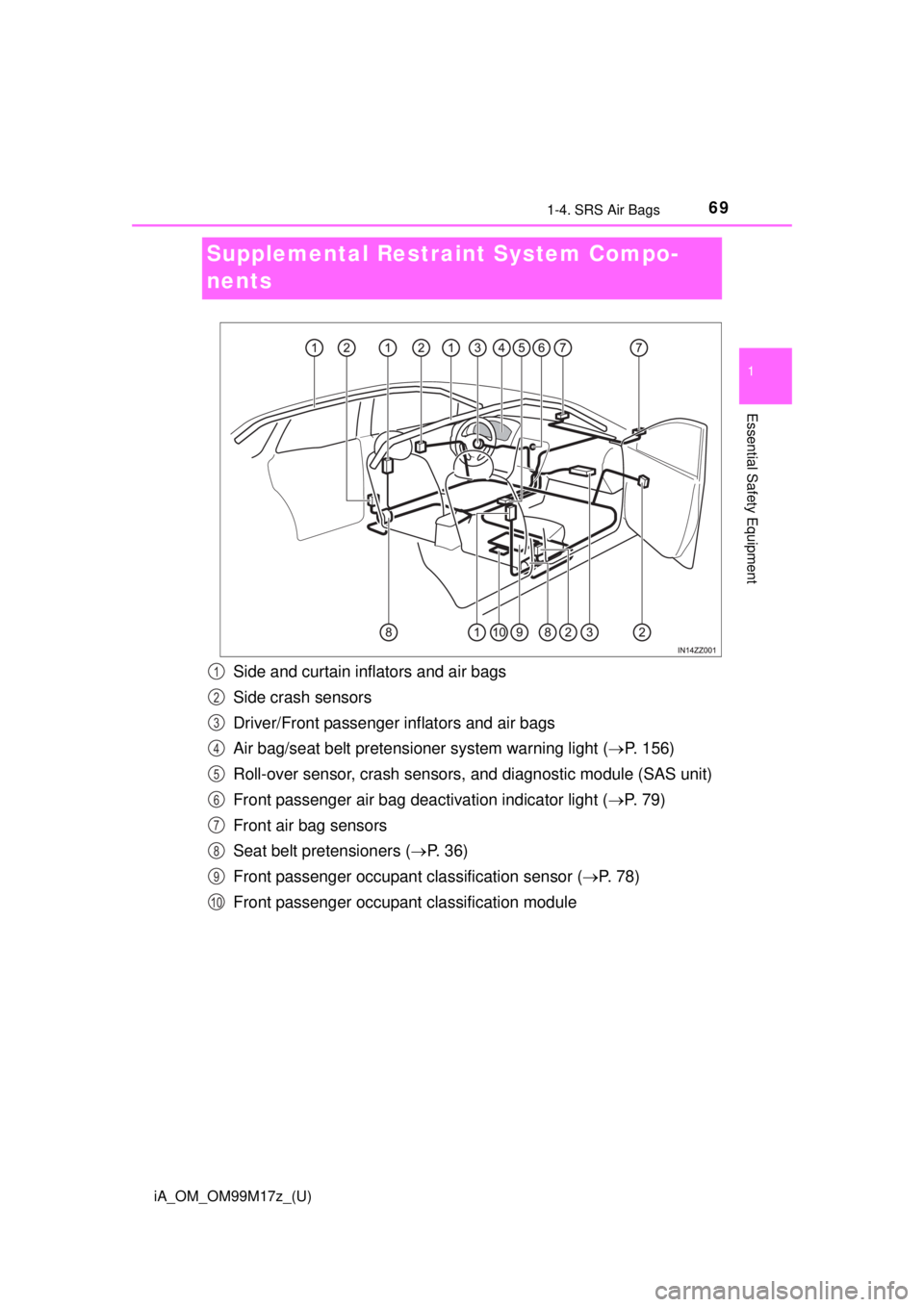
69
iA_OM_OM99M17z_(U)
1-4. SRS Air Bags
1
Essential Safety Equipment
Supplemental Restraint System Compo-
nents
Side and curtain inflators and air bags
Side crash sensors
Driver/Front passenger inflators and air bags
Air bag/seat belt pretensioner system warning light ( P. 156)
Roll-over sensor, crash sensors, and diagnostic module (SAS unit)
Front passenger air bag deactivation indicator light ( P. 7 9 )
Front air bag sensors
Seat belt pretensioners ( P. 3 6 )
Front passenger occupant classification sensor ( P. 7 8 )
Front passenger occupant classification module1
2
3
4
5
6
7
8
9
10
Page 70 of 588
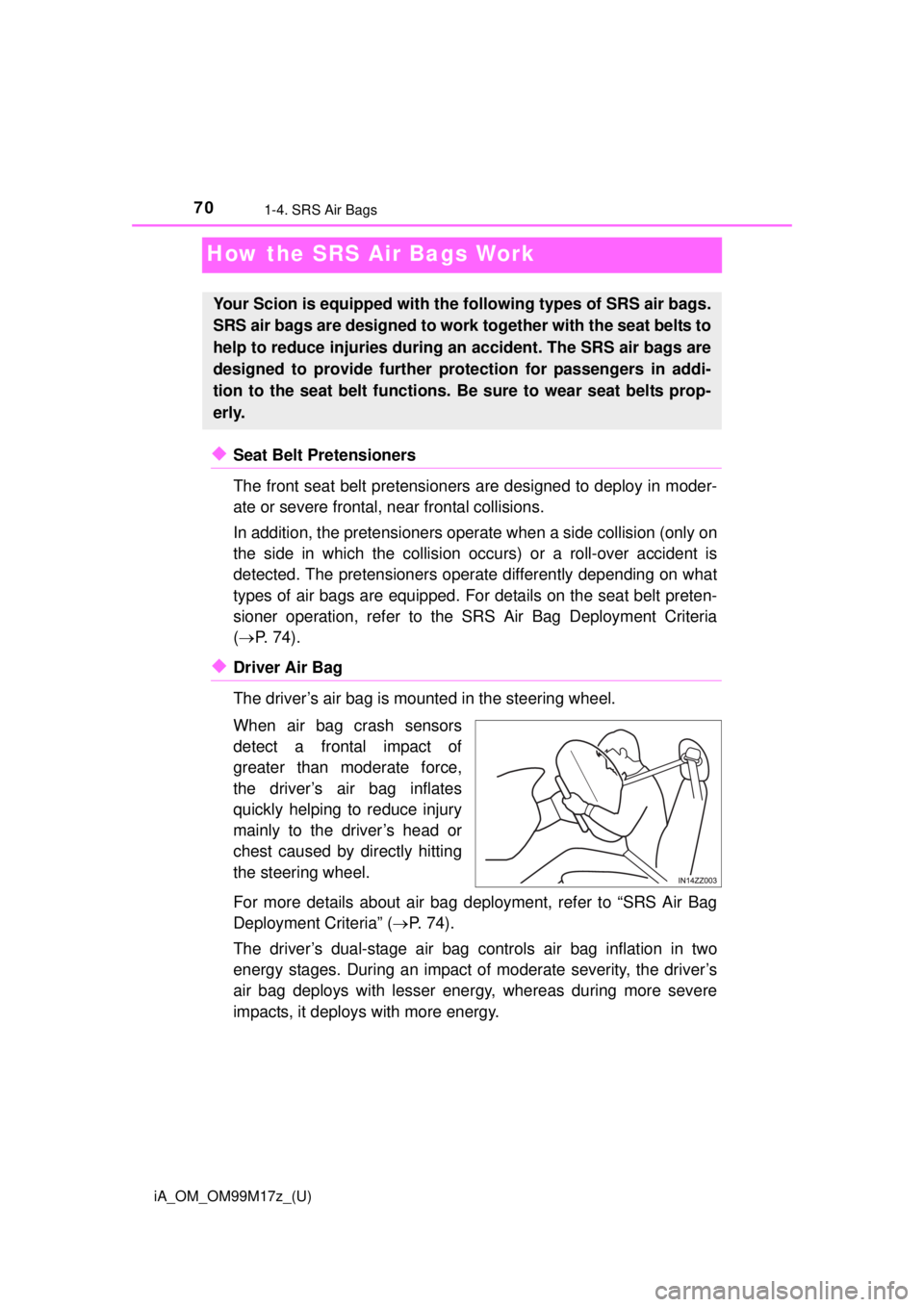
70
iA_OM_OM99M17z_(U)
1-4. SRS Air Bags
How the SRS Air Bags Work
◆Seat Belt Pretensioners
The front seat belt pretensioners are designed to deploy in moder-
ate or severe frontal, near frontal collisions.
In addition, the pretensioners operate when a side collision (only on
the side in which the collision oc curs) or a roll-over accident is
detected. The pretensioners operate differently depending on what
types of air bags are equipped. For details on the seat belt preten-
sioner operation, refer to the SRS Air Bag Deployment Criteria
( P. 74).
◆Driver Air Bag
The driver’s air bag is mounted in the steering wheel.
When air bag crash sensors
detect a frontal impact of
greater than moderate force,
the driver’s air bag inflates
quickly helping to reduce injury
mainly to the driver’s head or
chest caused by directly hitting
the steering wheel.
For more details about air bag deployment, refer to “SRS Air Bag
Deployment Criteria” ( P. 7 4 ) .
The driver’s dual-stage air bag c ontrols air bag inflation in two
energy stages. During an impact of moderate severity, the driver’s
air bag deploys with lesser energy, whereas during more severe
impacts, it deploys with more energy.
Your Scion is equipped with the following types of SRS air bags.
SRS air bags are designed to work together with the seat belts to
help to reduce injuries during an accident. The SRS air bags are
designed to provide further prot ection for passengers in addi-
tion to the seat belt functions. Be sure to wear seat belts prop-
erly.
Page 71 of 588
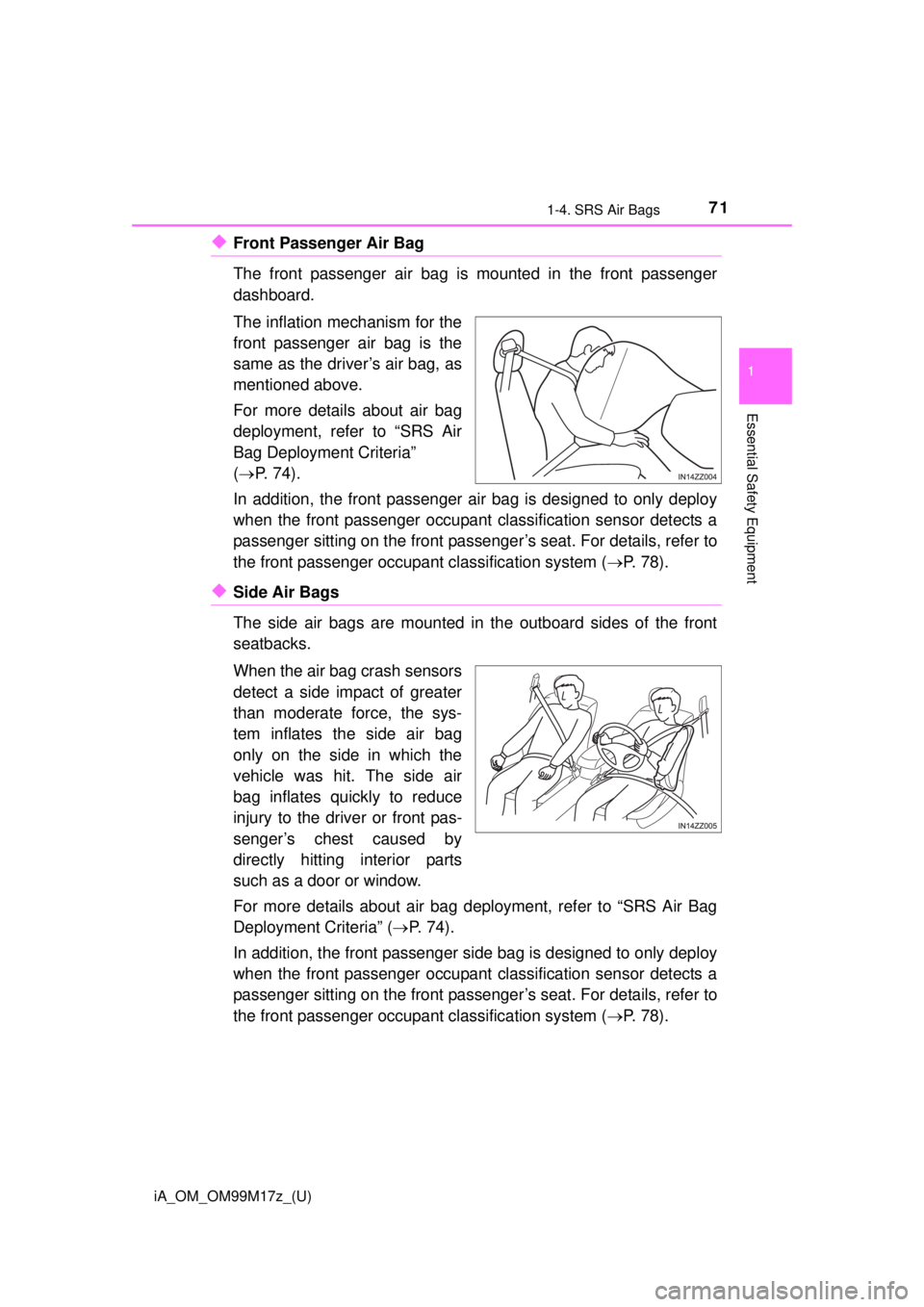
iA_OM_OM99M17z_(U)
711-4. SRS Air Bags
1
Essential Safety Equipment
◆Front Passenger Air Bag
The front passenger air bag is mounted in the front passenger
dashboard.
The inflation mechanism for the
front passenger air bag is the
same as the driver’s air bag, as
mentioned above.
For more details about air bag
deployment, refer to “SRS Air
Bag Deployment Criteria”
( P. 74).
In addition, the front passenger air bag is designed to only deploy
when the front passenger occupant classification sensor detects a
passenger sitting on the front passenger’s seat. For details, refer to
the front passenger occupant classification system (P. 78).
◆Side Air Bags
The side air bags are mounted in the outboard sides of the front
seatbacks.
When the air bag crash sensors
detect a side impact of greater
than moderate force, the sys-
tem inflates the side air bag
only on the side in which the
vehicle was hit. The side air
bag inflates quickly to reduce
injury to the driver or front pas-
senger’s chest caused by
directly hitting interior parts
such as a door or window.
For more details about air bag deployment, refer to “SRS Air Bag
Deployment Criteria” ( P. 7 4 ) .
In addition, the front passenger side bag is designed to only deploy
when the front passenger occupant classification sensor detects a
passenger sitting on the front passenger’s seat. For details, refer to
the front passenger occupant classification system (P. 78).
Page 72 of 588
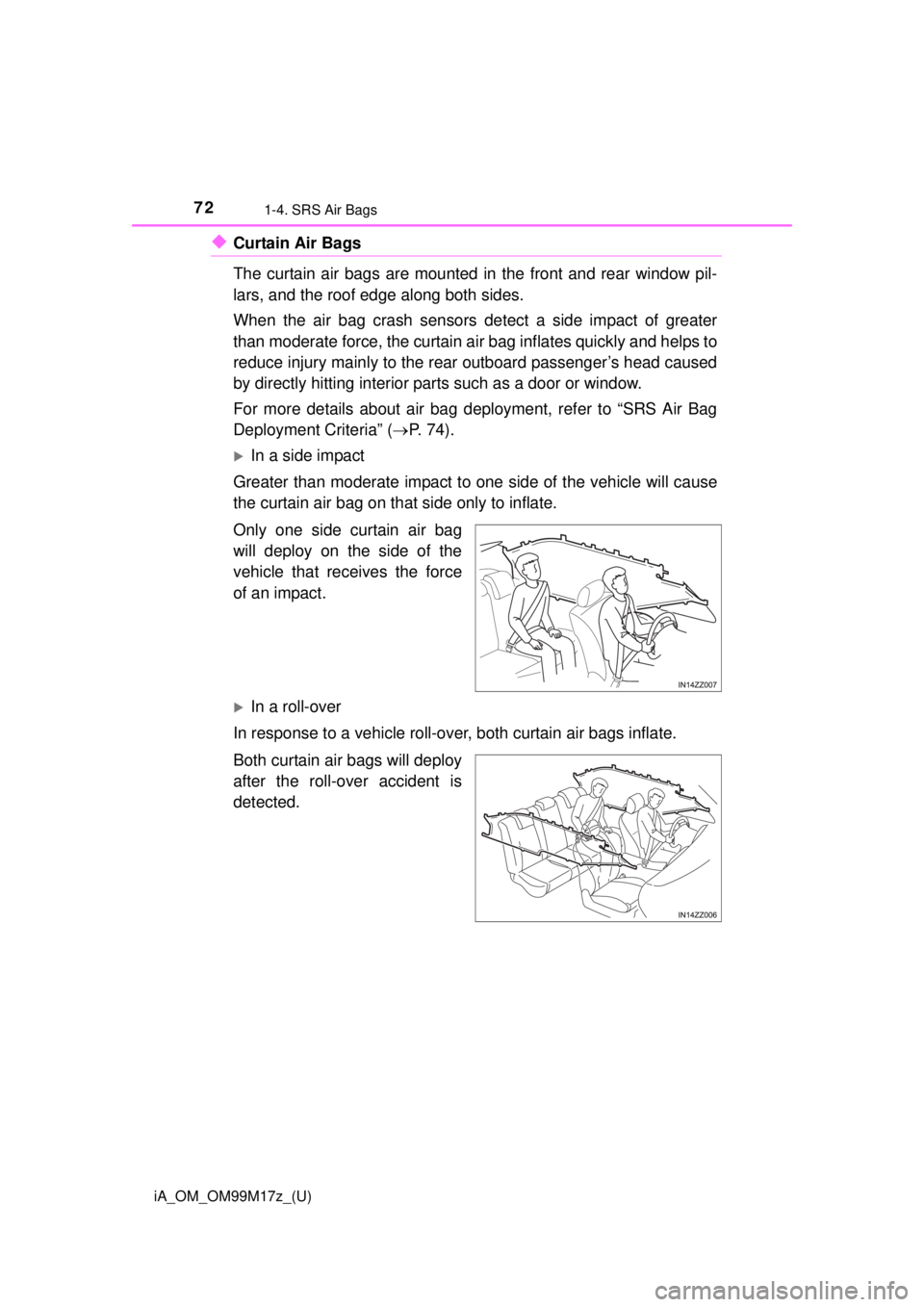
72
iA_OM_OM99M17z_(U)
1-4. SRS Air Bags
◆Curtain Air Bags
The curtain air bags are mounted in the front and rear window pil-
lars, and the roof edge along both sides.
When the air bag crash sensors detect a side impact of greater
than moderate force, the curtain ai r bag inflates quickly and helps to
reduce injury mainly to the rear outboard passenger’s head caused
by directly hitting interior pa rts such as a door or window.
For more details about air bag deployment, refer to “SRS Air Bag
Deployment Criteria” ( P. 7 4 ) .
In a side impact
Greater than moderate impact to one side of the vehicle will cause
the curtain air bag on that side only to inflate.
Only one side curtain air bag
will deploy on the side of the
vehicle that receives the force
of an impact.
In a roll-over
In response to a vehicle roll-over, both curtain air bags inflate.
Both curtain air bags will deploy
after the roll-over accident is
detected.
Page 75 of 588

iA_OM_OM99M17z_(U)
751-4. SRS Air Bags
1
Essential Safety Equipment
X: The SRS air bag equipment is designed to deploy in a collision.
*1:The front passenger front and side air bags and the seat belt pretensioner
are designed to deploy when the front passenger occupant classification
sensor detects a passenger sitting on the front passenger’s seat.
*2:In a side collision, the seat belt pretensioners and the side/curtain air bags
deploy (only on the side in which the collision occurs).
*3:In a roll-over accident, the seat belt pretensioners and the curtain air bags
deploy.
In a frontal offset collision, the equipped air bags and pretensioners may all
deploy depending on the direction, angle, and rate of impact.
Page 78 of 588

78
iA_OM_OM99M17z_(U)
1-4. SRS Air Bags
Front Passenger Occupant Classification
System
Your vehicle is equipped with a front passenger occupant classifica-
tion sensor as a part of the supple mental restraint system. This sen-
sor is equipped in the front passenger’s seat cushion. This sensor
measures the electrostatic capacity of the front passenger’s seat. The
SAS unit is designed to prevent the front passenger front and side air
bags and seat belt pretensioner syst em from deploying if the front
passenger air bag deactivation indicator light turns on.
To reduce the chance of injuries caused by deployment of the front
passenger air bag, the system deac tivates the front passenger front
and side air bags and also the seat belt pretensioner system when the
front passenger air bag deactivation indicator light turns on. Refer to
the following table for the front passenger air bag deactivation indica-
tor light illumination conditions.
This system shuts off the front pa ssenger front and side air bags and
seat belt pretensioner system, so make sure the front passenger air
bag deactivation indicator light turns on according to the following
table.
The air bag/front seat belt pretensioner system warning light flashes
and the front passenger air bag deactivation indicator light illuminates
if the sensors have a possible malfun ction. If this happens, the front
passenger front and side air bags and seat belt pretensioner system
will not deploy.
First, please read “Supplementa l Restraint System (SRS) Pre-
cautions” ( P. 62) carefully.
Front Passenger Occupant Classification Sensor
Page 79 of 588
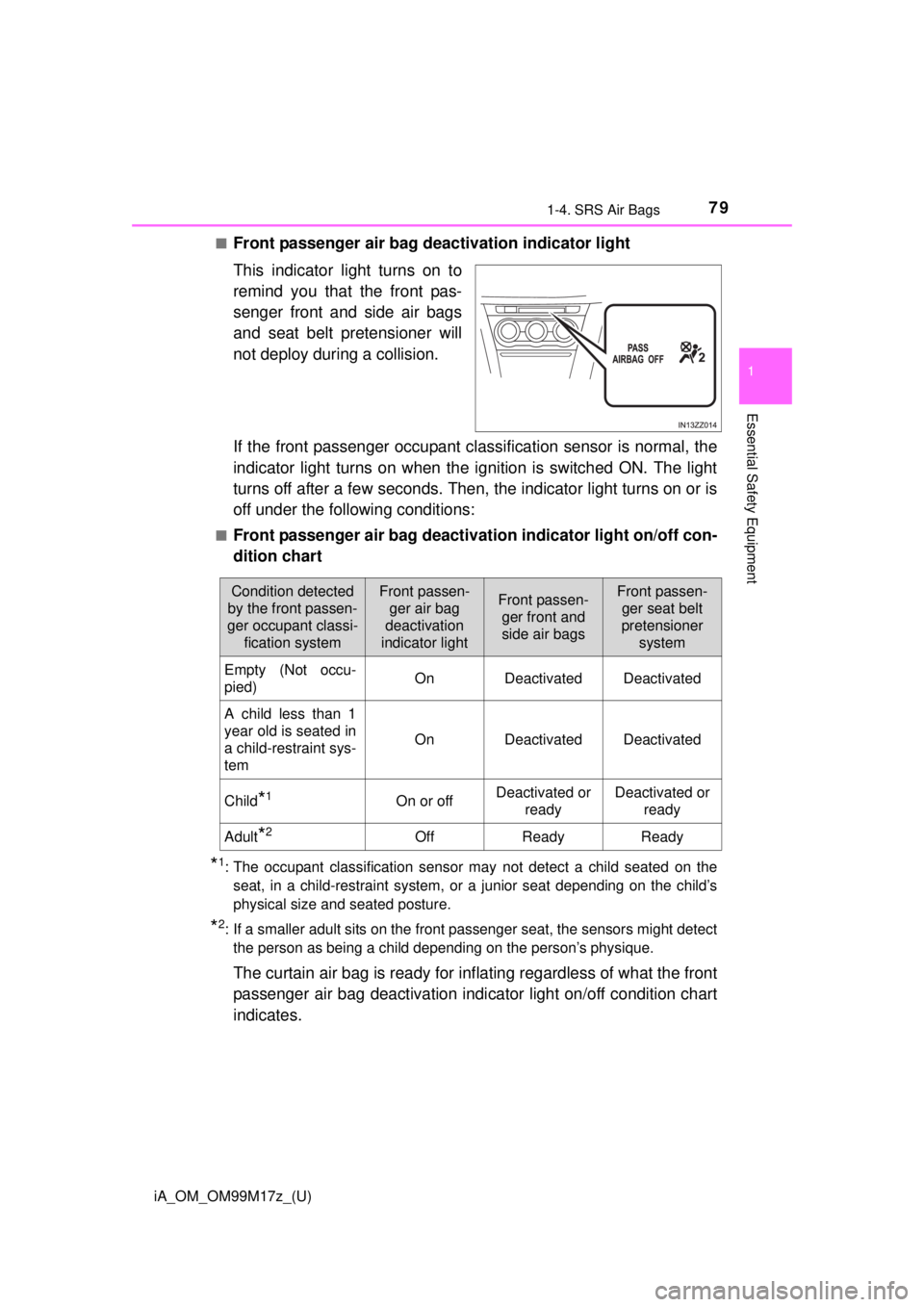
iA_OM_OM99M17z_(U)
791-4. SRS Air Bags
1
Essential Safety Equipment
■Front passenger air bag deactivation indicator light
This indicator light turns on to
remind you that the front pas-
senger front and side air bags
and seat belt pretensioner will
not deploy during a collision.
If the front passenger occupant clas sification sensor is normal, the
indicator light turns on when the ignition is switched ON. The light
turns off after a few seconds. Then, the indicator light turns on or is
off under the following conditions:
■Front passenger air bag deactivation indicator light on/off con-
dition chart
*1: The occupant classification sensor may not detect a child seated on the seat, in a child-restraint system, or a junior seat depending on the child’s
physical size and seated posture.
*2: If a smaller adult sits on the front passenger seat, the sensors might detectthe person as being a child depending on the person’s physique.
The curtain air bag is ready for inflating regardless of what the front
passenger air bag deactivation indi cator light on/off condition chart
indicates.
Condition detected
by the front passen-
ger occupant classi-
fication systemFront passen-ger air bag
deactivation
indicator lightFront passen- ger front and
side air bagsFront passen- ger seat belt
pretensioner
system
Empty (Not occu-
pied)OnDeactivatedDeactivated
A child less than 1
year old is seated in
a child-restraint sys-
tem
OnDeactivatedDeactivated
Child*1On or offDeactivated or readyDeactivated or ready
Adult*2OffReadyReady
Page 81 of 588
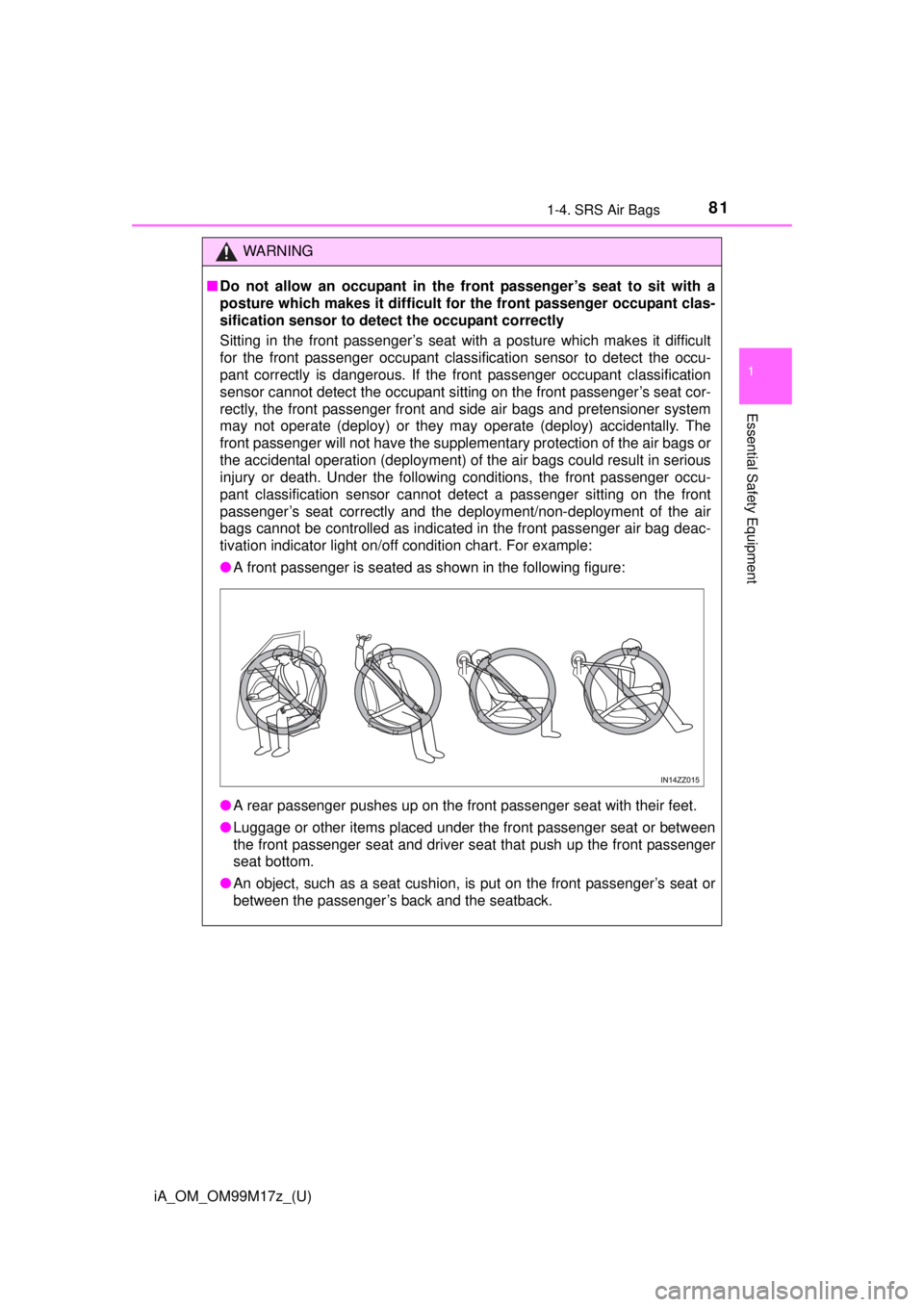
iA_OM_OM99M17z_(U)
811-4. SRS Air Bags
1
Essential Safety Equipment
WARNING
■Do not allow an occupant in the front passenger’s seat to sit with a
posture which makes it difficult fo r the front passenger occupant clas-
sification sensor to detect the occupant correctly
Sitting in the front passenger’s seat with a posture which makes it difficult
for the front passenger occupant classification sensor to detect the occu-
pant correctly is dangerous. If the front passenger occupant classification
sensor cannot detect the occupant sitting on the front passenger’s seat cor-
rectly, the front passenger front and side air bags and pretensioner system
may not operate (deploy) or they may operate (deploy) accidentally. The
front passenger will not have the supplementary protection of the air bags or
the accidental operation (deployment) of the air bags could result in serious
injury or death. Under the following conditions, the front passenger occu-
pant classification sensor cannot detect a passenger sitting on the front
passenger’s seat correctly and the deployment/non-deployment of the air
bags cannot be controlled as indicated in the front passenger air bag deac-
tivation indicator light on/off condition chart. For example:
● A front passenger is seated as shown in the following figure:
● A rear passenger pushes up on the front passenger seat with their feet.
● Luggage or other items placed under the front passenger seat or between
the front passenger seat and driver seat that push up the front passenger
seat bottom.
● An object, such as a seat cushion, is put on the front passenger’s seat or
between the passenger’s back and the seatback.
Page 82 of 588

82
iA_OM_OM99M17z_(U)
1-4. SRS Air Bags
WARNING
■Do not allow an occupant in the front passenger’s seat to sit with a
posture which makes it difficult fo r the front passenger occupant clas-
sification sensor to detect the occupant correctly
● A seat cover is put on the front passenger’s seat.
● Luggage or other items are placed on the seat with the child in the child-
restraint system.
● A rear passenger or luggage push or pull down on the front passenger
seatback.
● Luggage or other items are placed on the seatback or hung on the head
restraint.
● The seat is washed.
● Liquids are spilled on the seat.
● The front passenger seat is moved backward, pushing into luggage or
other items placed behind it.
● The front passenger seatback contacts the rear seat.
● Luggage or other items are placed between the front passenger seat and
driver seat.
● An electric device is put on the front passenger’s seat.
● An additional electrical device, such as a seat warmer is installed to the
surface of the front passenger seat.
The front passenger front and side air bags and seat belt pretensioner sys-
tems will deactivate if the front passenger air bag deactivation indicator light
turns on.
NOTICE
● To assure proper deployment of the front air bag and to prevent damage to
the sensor in the front seat cushion:
• Do not place sharp objects on the front seat cushion or leave heavy lug-
gage on them.
• Do not spill any liquids on the front seats or under the front seats.
● To allow the sensors to function properly, always perform the following:
• Adjust the front seats as far back as possible and always sit upright
against the seatbacks with seat belts worn properly.
• If you place your child on the front passenger seat, secure the child-
restraint system properly and slide the front passenger seat as far back
as possible ( P. 50).
Page 83 of 588

83
iA_OM_OM99M17z_(U)
1-4. SRS Air Bags
1
Essential Safety Equipment
Constant Monitoring
The following components of the air bag systems are monitored by a
diagnostic system:
●Crash sensors, and diagnostic module (SAS unit)
● Front air bag sensors
● Air bag modules
● Side crash sensors
● Air bag/Front seat belt pretensioner system warning light
● Front seat belt pretensioners
● Related wiring
● Front passenger air bag deactivation indicator light
● Front passenger occupant classification sensor
● Front passenger occupant classification module
The diagnostic module continuously monitors the system’s readiness.
This begins when the ignition is switched ON and continues while the
vehicle is being driven.